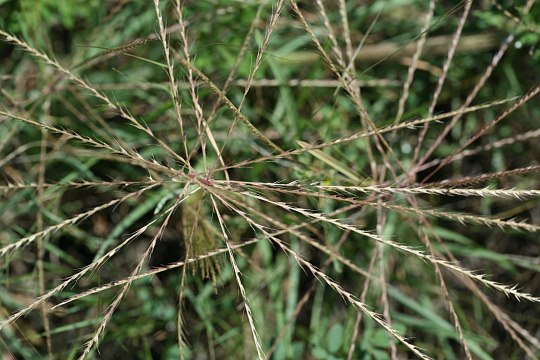Description: This adventive perennial grass is ½–1¼' tall and tufted at the base, consisting of fertile and infertile shoots. Fertile shoots have 2-4 alternate leaves along the lower-third of the culm, while infertile shoots have about 4 leaves that are sheathed together in the shape of a fan. The culms are pale green to tan, somewhat flattened, glabrous, and unbranched. The leaf blades of fertile shoots are about 2 mm. across and 3-4" long; they are light blue-gray to pale green, hairless, and ascending to spreading. The leaf blades of infertile shoots are the same as those of the fertile shoots, except they are often somewhat longer (up to 6½" in length). The leaf sheaths are light blue-gray to pale green, hairless, and membranous along their margins; they are often rather loosely attached to their culms. The ligule at the junction of each blade and sheath has a papery membrane and a few white hairs.

Each fertile shoot terminates in a large inflorescence up to 5½" tall and 11" across. This inflorescence has whorls or near-whorls of floral spikes along its central axis (or rachis). The lower to middle whorls of spikes are widely spreading, while the upper spikes are ascending and somewhat shorter in length. Each floral spike is up to 5½" long; small spikelets are evenly distributed along its length. Each spikelet is about 4 mm. long (excluding the awns) and V-shaped at the base; it has a pair of glumes, a fertile lemma, and an infertile lemma. One glume is about 3 mm. long, while the other glume is about 4 mm. long; they are narrowly lanceolate and keeled. The fertile lemma 2-3 mm. long, and folded along its length; at the apex, it has an awn about 5-8 mm. long. The infertile lemma is 1.5–2 mm. long, folded along its length, and obtuse or truncate at its apex, where there is an awn about 3-4 mm. long. In Illinois, the blooming period occurs during the summer. The spikelets are initially reddish green, but they later turn tan or brown when the grains become ripe. At this time, the entire inflorescence may break off and tumble in the wind, thereby distributing the grains. The root system is fibrous and rhizomatous; sometimes rootlets form along the lower nodes of the culms. Where there is little competition from other vegetation, this grass often forms vegetative colonies.